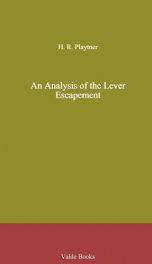An Analysis of the Lever Escapement

from the PREFACE:In any modern work on horology of value, the metric system is used. Skilled horologists use it on account of its convenience. The millimeter is a unit which can be handled on the small parts of a watch, whereas the inch must always be divided on anything smaller than the plates.Equally as fine gauges can be and are made for the inch as for the metric system, and the inch is decimally divided, but we require another decimal point to express our measurement.No one can comprehend the geometrical principles employed in escapements without a knowledge of angles and their measurements, therefore we deem it of sufficient importance to at least explain what a degree is, as we know for a fact, that young workmen especially, often fail to see how to apply it.Every circle, no matter how large or small it may be, contains 360 degrees; a degree is therefore the 360th part of a circle; it is divided into minutes, seconds, thirds, etc.To measure the value of a degree of any circle, we must multiply the diameter of it by 3.1416, which gives us the circumference, and then divide it by 360. It will be seen that it depends on the size of that circle or its radius, as to the value of a degree in any actual measurement. To illustrate; a degree on the earth's circumference measures 60 geographical miles, while measured on the circumference of an escape wheel 7.5 mm. in diameter, or as they would designate it in a material shop, No. 7 1/2, it would be 7.5 [multiplied by] 3.1416 [divided by] 360 = .0655 mm., which is equal to the breadth of an ordinary human hair; it is a degree in both cases, but the difference is very great, therefore a degree cannot be associated with any actual measurement until the radius of the circle is known. The lines can be verified by means of the compass, which is a good practical method.Drop equals the amount of freedom which is allowed for the action of pallets and wheel. See Z, Fig. 1.Primitive or Geometrical Diameter.--In the ratchet tooth or English wheel, the primitive and real diameter are equal; in the club tooth wheel it means across the locking corners of the teeth; in such a wheel, therefore, the primitive is less than the real diameter by the height of two impulse planes.Lock equals the depth of locking, measured from the locking corner of the pallet at the moment the drop has occurred.Run equals the amount of angular motion of pallets and fork to the bankings after the drop has taken place.Total Lock equals lock plus run.A Tangent is a line which touches a curve, but does not intersect it. AC and AD, Figs. 2 and 3, are tangents to the primitive circle GH at the points of intersection of EB, AC, and GH and FB, AD and GH.Impulse Angle equals the angular connection of the impulse or ruby pin with the lever fork; or in other words, of the balance with the escapement.Impulse Radius.--From the face of the impulse jewel to the center of motion, which is in the balance staff, most writers assume the impulse angle and radius to be equal, and it is true that they must conform with one another. We have made a radical change in the radius and one which does not affect the angle. We shall prove this in due time, and also that the wider the impulse pin the greater must the impulse radius be, although the angle will remain unchanged.We will give our method of drafting the escapement, which happens in some respects to differ from others. We believe in making a drawing which we can reproduce in a watch. --This text refers to the Kindle Edition edition.
Info about the book
Author:
Series:
Unknown
ASIN:
B0083ZXGKU
Rating:
3.5/5 (3)Your rating:
0/5
Languge:
English
Users who have this book
Users who want this book
What readers are saying
What do you think? Write your own comment on this book!
write a commentif you like An Analysis of the Lever Escapement try:
Other books by this author
Do you want to exchange books? It’s EASY!
Get registered and find other users who want to give their favourite books to good hands!

